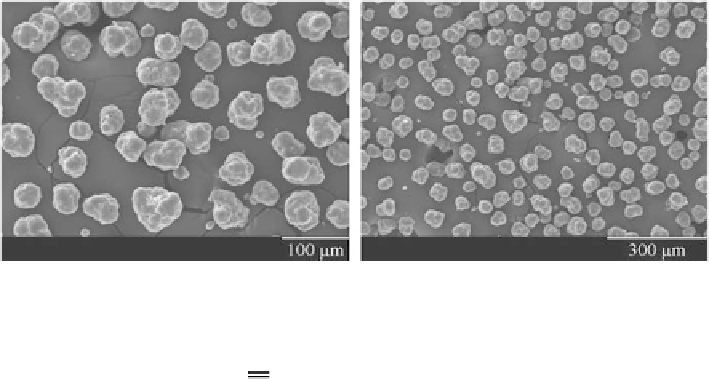Geoscience Reference
In-Depth Information
Fig. 9 Polyamide tracer particles used for seeding (Adapted from Ricardo
2008
)
1
u
p
2p
f
c
C
u
f
r
p
¼
1
þ
(5)
where
u
p
is the velocity of the seeding particles and
u
f
is the velocity of the fluid,
18
v
ðwÞ
sd
2
C
¼
(6)
and
f
c
is the turbulent frequency. Equation (
5
) expresses the ability of the seeding
particle to follow the fluid turbulent micro-structure whose scale is
f
c
(expressed in
terms of frequencies) as a function of its density and diameter, included in parame-
ter
C
. The closer the ratio
r
p
is to unity, the better the tracking capability. In most
cases, the difference of densities is not large. The application of (
5
) is justifiable for
its conceptual simplicity as it retains the most important effects of drag and inertia
(Melling
1997
). It renders thus a conservative estimate of the tracking ability of the
tracers. The graphical expression of (
5
) is seen in Fig.
10
for polyamide particles.
Melling (
1997
) proposed a threshold of acceptability of
r
p
¼
0.95 to quantify the
tracking ability. Using this criterion, from Fig.
10
one concludes that particles of
50
m
m are unsuitable to express turbulent scales higher than 13 Hz. Note that a
common PIV system whose time resolution is 15 Hz has a Nyquist frequency of
7.5 Hz. Hence, in the time domain, the seeding particles would introduce errors. In
the space domain, using Taylor's frozen turbulence hypothesis (Tennekes and
Lumley
1972
), and a velocity of 0.2 ms
1
, the cut-off frequency of 13 Hz represents
a turbulent scale of 0.015 m. This means that the velocity of eddies smaller than
0.015 m would be measured with less than 95% confidence.
The measuring principle of PIV measurements can be illustrated in Fig.
11
. The
planar flow region is divided into areas, designated interrogation areas. If the mean
vertical and the longitudinal displacements of the particles illuminated in a given
interrogation area centered at (
x,z
) are found, the longitudinal and vertical velocities

